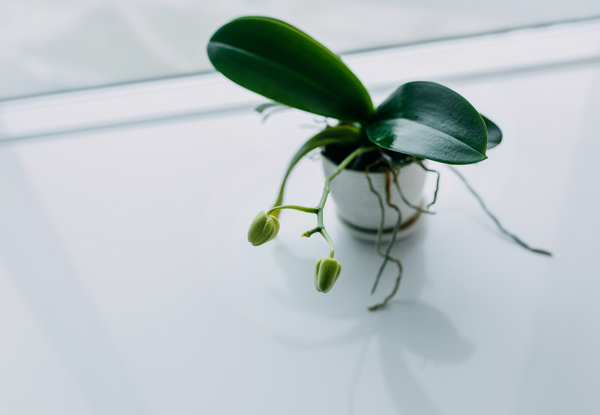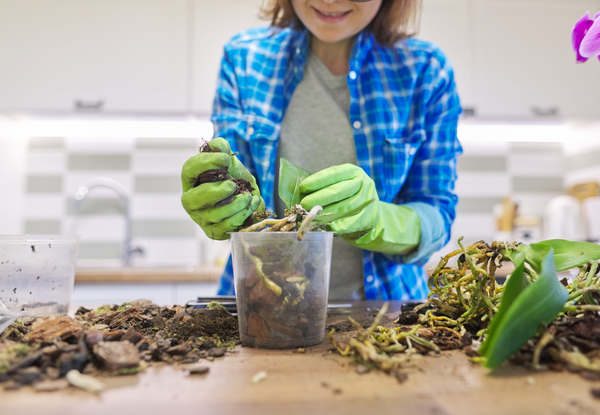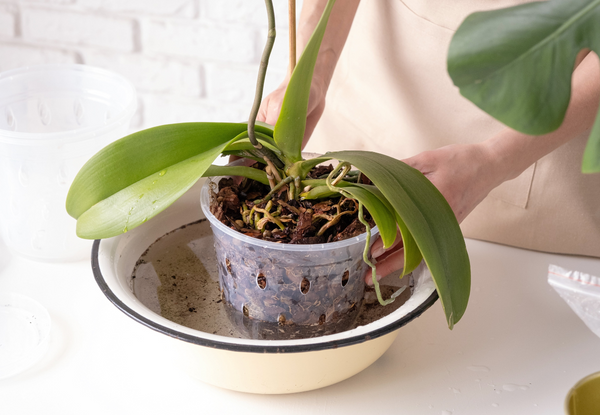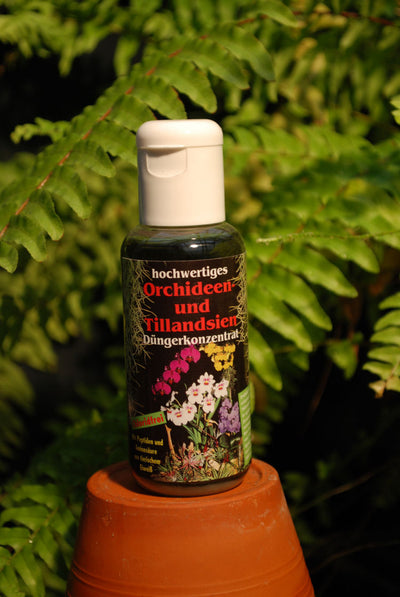Repotting orchids - how to do it
On the one hand, the orchid is considered to be one of the most beautiful and popular houseplants , but on the other hand it is said to be very demanding to care for. While it is true that careful care has a positive effect on the plant, the actual plant care is not particularly complicated.
So that you can take the best possible care of your orchid in the future, we will tell you in this blog post what you need to consider when repotting orchids and which tips and tricks you can use to do something good for your plants.
Our step-by-step guide to repotting orchids
Repotting an orchid from the old pot to the new one is much less complicated than you might think. With our step-by-step guide, you will have repotted your orchid in just five easy steps:
Step 1: Remove the orchid from the old pot
Begin repotting by carefully removing the plant from its old pot. If the pot has become noticeably too small , the plant's roots will already be pressing against the edge of the pot, which often makes repotting difficult.

If you have used a plastic pot that you do not want to use again, you can cut it open to gently remove the plant from the too-small pot. If this is not possible, parts of the roots may break when repotting. However, as long as there are only a few or old root parts, the orchid can cope with this.
Step 2: Care for and clean the orchid
Once you have successfully removed the orchid from its pot, you can use the opportunity to care for the plant. Cut off any dried or rotten roots, remove any yellowed leaves and free the intact roots of the plant from any remains of the orchid substrate.
Step 3: Place the orchid in the new pot
To place the orchid in the new pot, first gently push the aerial roots of the plant down towards the other roots. Be careful here and make sure that you do not break or damage the aerial roots. Now place the plant in the new pot.
Step 4: Fill the new pot with soil and/or orchid substrate
Now you can slowly fill the pot with soil and/or orchid substrate . Make sure that the plant's roots have enough space in the pot and that the root ball does not protrude over the edge after placing it in the pot.

Sometimes it is helpful to carefully twist the roots of the plant together and then use a little sensitivity to push the substrate into the spaces between the plant roots. Alternatively, you can tap the pot lightly on the table several times until the soil and/or substrate is evenly distributed around the roots.
Step 5: Water the orchid thoroughly
Finally, you should water your orchid . Especially because fresh substrate does not absorb water very well, the orchid needs to be watered extensively after repotting. Therefore, you should not only moisten the plant with a spray bottle, but also give it a water bath.
To do this, fill the orchid's planter with water and leave the plant in the water bath for up to 30 minutes. Then make sure that the orchid can drain well and remove all the water from the planter. Pay extra attention to your orchids in the first few weeks after repotting. The plants may need to be watered more often than usual during this time.
What else you should pay attention to when repotting: Our tips for orchid lovers
It is worth investing some time in the careful care of orchids, as this will ensure that your plants remain healthy and continue to delight you.
We would like to give you three tips that you should consider when repotting orchids if you want to do something good for yourself and your plants.
Tip 1: When repotting, give your orchid time to heal cuts
If you notice rotten or dried roots on your plant, you should cut them off. Instead of repotting straight away, you can leave the plant on newspaper for a day . This will allow the cuts on the plant to heal before the final transplant.
Tip 2: Replant your orchid more often than using a pot that is too big
Get the most out of your plant by choosing a pot that is just one size larger than the previous pot when repotting. This will allow your orchid to continue growing safely. A pot that is too large can be detrimental to the growth of your plant.
Tip 3: Use high-quality planting materials for your orchids
Do something good for your plant by using high-quality planting materials and buy products such as orchid soil or orchid substrate directly from an orchid specialist . This way you can be sure that your plant gets exactly what it needs and you also have the chance to get advice on the needs of the different orchid species.
What else you should know about proper orchid care
In order to keep your orchid healthy in the long term, you should not only follow the correct practice for repotting the plant, but also pay attention to the appropriate care . To do this, you should first familiarize yourself with the specific needs of your plant. This includes, for example, the right amount of light and water as well as regular checks for pests and diseases.

Always make sure that you place your orchid in a suitable location, that you water it sufficiently, fertilize it regularly and prune it . Your orchids will thank you with beautiful flowers and longevity.
We will be happy to give you further tips on how to properly handle and care for your orchids in Henni’s Orchid Blog .
Our FAQ on repotting orchids
Since the well-being of your orchids is important to us and new questions keep coming up on the subject of "repotting orchids", we have summarized the answers to some frequently asked questions for you in our FAQ:
When do you have to repot orchids?
If you keep an eye on your orchids regularly, you will easily know when it is time to repot them: if the roots are pressing against the pot wall or are already taking up so much space that they are easily lifting the orchid out of the pot, it is time to put your plant in a new planter. This is usually the case with orchids every two to three years .
Repotting is particularly useful in spring, when the orchids are getting new shoots and root tips. However, you should avoid repotting during the flowering period of the plants, as this is already a very energy-intensive time for the orchids and repotting would cost additional energy.
Can I repot my Phalaenopsis orchids even when they have flowers?
While it is worth waiting until the flowering period is over before repotting most orchid species, Phalaenopsis orchids produce flowers almost continuously. If this orchid species needs a new pot, you may not be able to wait until after the flowering period to repot.
If you want to repot your Phalaenopsis orchid while it is flowering, cut off the flower stems during repotting . This way you will lose the beautiful flowers for a short time, but you can be sure that the plant can use its energy to take root in the new pot.
Do I need to use special soil to repot orchids?
Orchids are tropical epiphytes that usually grow on the branches of trees in the rainforest and get their nutrients from the deposits there. The orchid is therefore a plant that has adapted to its natural habitat.
In order to provide your orchid with all the nutrients it needs at home, you should use a substrate instead of conventional potting soil. The airy orchid soil is a bit reminiscent of bark mulch and its texture is similar to the substrate in the rainforest.
In addition to orchid soil, there are other products that are specifically tailored to the needs of orchids. For example, you can also use orchid substrate or orchid fertilizer to optimally care for your plants.
What is an orchid pot?
Anorchid pot is a planter that is specially adapted to the needs of orchids. They differ from other pots in some respects. For example, orchid pots have several holes in the bottom that allow excess water to drain away.
There are various types of orchid pots, but the transparent plastic orchid pots are particularly popular. These pots have the advantage that additional holes can be drilled into them later and they also allow the plant lover to closely observe the roots of the plant and its growth. Orchid pots are available in different sizes and with different diameters, so that you can repot the plant into a slightly larger pot if necessary.
Where can I buy supplies for repotting orchids?
If you want to buy high-quality accessories for repotting your orchids, it is best to do this directly from an orchid specialist. You can usually find everything you need for repotting your orchids in larger garden centers.
In our online shop, we also offer a large selection of different types of orchids as well as various accessories for caring for your plants. Feel free to familiarize yourself with our range or contact us if you need help choosing the right plants and accessories.















Können Sie mir ein Umtopfset zusammenstellen wie Sie es in Ihrer Gärtnerei beim Umtopfen benutzen. Substrat, Dünger hilfreiches Werkzeug etc. Anleitung. Ich habe Orchideen in verschiedenen Größen in blühender und ruhender Phase.
Sie würden mir helfen. Danke
Leave a comment